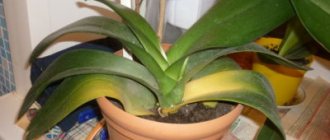"Home" types of bells
Usually on our window sills and balconies there are subspecies of Campanula equifolia: “Alba” and “Maya”. “Alba” has white inflorescences, for which people call it “the bride.” “Maya” has blue ones, she is called “groom”. But there are also bicolor plants - “Bicolor”, popularly known as “lover”. But in fact, sometimes there are other varieties of campanula, for example: “Karpatskaya”, “Terry”, “Blauranka”. The table shows the distinctive features of the most common plant varieties.
Table - Varieties of “domesticated” campanula
| Name | Features of the variety |
| "Alba" | — Ampel (flexible stems up to 40 cm long); - flowers are white, 3 cm in diameter; - leaves are light green, with jagged edges, rounded, up to 3 cm long; - solitary inflorescences |
| "Alba Atlanta" | — Semi-ampel; — the stems are thicker and shorter than those of “Alba”, forming a flowering “cap” above the pot; - flowers are white, 3 cm in diameter; — the leaves are light green, the edges are more “carved” than those of “Alba”; - at the end of each stem there are several inflorescences |
| "Mayan" | — Ampel; - flowers are identical to “Alba”, but shades: from blue to blue-violet; - leaves are “fluffy”, with a grayish tint; - stems are grayish; - petals are smooth |
| "Napoli" | — Semi-ampel; - flowers are blue, blue-violet, more saturated in color than those of “Maya”; - leaves are light green, smooth; - petals are velvety, textured |
| "Bicolor" | — Semi-ampel; - flowers are white at the core and lilac-blue at the edges; - leaf smooth, green; - petals are smooth; - inflorescence shape - star-shaped |
| "Brittle" | — Ampel; - flowers are blue, may have a lilac tint; - leaves are green, fleecy; - a long stem-“peduncle” grows from the “rosette”; - solitary inflorescences |
| "Blauranka" | — Semi-ampel; - flowers are light blue, larger than those of equal-leaved varieties; — stems are powerful, up to 20 cm high; - solitary inflorescences |
| "Terry" | — Ampel; - double inflorescences (a sort of “multi-layered” bell), colors respectively: white (for the “bride”), blue (for the “groom”) and two-color (for the “lover”); - leaves are green, with jagged edges |
| "Karpatskaya" | — Semi-ampel: — highly branching short stems; - the flower looks like a star or an open bell; - color: white for the “bride” and shades of blue or purple for the “groom” |
A huge number of hybrid varieties of Campanula have been bred; only professional gardeners can distinguish them from each other.
Delicacy of petals and intricate shapes
Campanula belongs to the genus of herbaceous crops of the Bellflower family. In nature, the plant is found in Europe, North America, Central Asia and the Caucasus. Grows in the steppe, meadows, forest clearings and mountain slopes. The scientific name "campanula" means "bell".
However, people call the flower:
- chebotki;
- bells;
- birdbirds;
- chenilles;
- family happiness.
Biologists classify more than 400 species of campanula, which are grown both in open ground and at home. The most popular variety of indoor bellflower is Campanula equifolia. It is a perennial plant with hanging branches, the length of which reaches approximately 30 cm. Since caring for the campula at home is quite simple, it decorates many living spaces and courtyards.
The alternate leaf blades, long-petioled, are colored light green. The edges are jagged. The leaf length varies from 3 to 7 cm. The maximum diameter of the buds reaches 4 cm.
They are originally collected in paniculate inflorescences and painted in the following colors:
- soft pink;
- snow-white;
- lilac;
- lilac;
- blue.
They often form at the tips of graceful shoots, which look original against the backdrop of lush greenery.
Despite its attractive appearance, after a few years the plant loses its decorative effect.
Rules for caring for Campanula
In general, the bell is a very unpretentious plant, and even a novice gardener or a person who is not at all knowledgeable in this matter can master growing campanula at home.
Light
Campanula loves light, but it must be diffused. That is, the lighting should be bright, but without direct sunlight. In the garden or on the balcony, choose a place where there is always shade. In an apartment, place the plant on the window sills of windows facing east and west. If your windows face south, then it is better to place a pot of campanula mix in a flowerpot or place it on a special rack.
Direct sunlight causes the plant to “stretch” its leaves, and the inflorescences, on the contrary, become rarer and smaller. In addition, Campanella Port Blue “stretches” towards the sun, which affects the shape of the flower. But you shouldn’t radically turn the pot with different sides to the luminary, trying to straighten the stems, as this will only cause harm - the plant will turn out to be chaotically twisted and shapeless. Take your time and turn the plant gradually.
Temperature
Campanula loves coolness, but can hardly tolerate heat. Optimal temperature for the plant:
- in summer - 23(±2)°C, but not higher. If your climate is hot, then the plant will do better in a room with air conditioning, but place it so that cold air does not blow on it;
- in winter - approximately 13(±2)°C. The flower “suffers” from excessive heat, the leaves dry out, and in the spring you may not wait for flowering or it will be sparse.
During the heating season, it is better to remove the campanula from the windowsill under which the radiator is located. Also, in winter you should not place the plant near heating appliances and gas stoves.
Humidity
This point is not important for the campanula. You won’t have to fuss with trays, spray water from a spray bottle, trying to humidify the air, and you won’t need any other “dancing” around the flower.
Spraying is carried out only in extreme heat or during the heating season, if the plant is located near a radiator. Spray water only from below, on the soil and leaves. If drops fall on the inflorescences, unsightly brown spots will appear.
Lure
But this is a very important moment for the flower. In the active phase (from March to September), rapid flowering “extracts” all the strength from the “bride and groom”. During such a stressful period, the plant needs help.
You can feed Campanula with any store-bought fertilizer for decorative flowering indoor plants. Only the dosage needs to be reduced by half from that recommended by the manufacturer. It is optimal to carry out the procedure three times a month.
Pot
The campanula root system grows rapidly and quite quickly occupies the entire space of the pot. And then the plant dries out its buds - this is a sure sign that it is “crowded” and lacks nutrients. Therefore, immediately after purchase, it is better to transplant the campanula into a spacious “dwelling” - a low and wide pot.
Transfer
Campanula is not a perennial plant. And it needs to be replanted only if the old pot has become too small and obvious signs of “starvation” are observed: the leaves turn yellow, fall off, the buds dry out, and the flowering fades.
Campanula loves loose, “porous” soil. The best option is a mixture of peat soil, humus and sand in equal parts. But a universal store-bought composition for ornamental flowering plants will also work. The ideal time to plant campanula is spring and autumn. If you decide, then follow these five steps.
- Pick a pot. First, find a suitable size pot for the plant. It should be about twice as large as the previous one.
- Install drainage. At the bottom of the new pot you need to pour fresh drainage, 2 cm thick.
- Add soil. Pour soil onto the drainage, but not to the edges of the pot. Half the depth of the flowerpot is enough.
- Set flower. Move the plant along with a piece of old soil on the roots in the center of the container and not too deep - about 2 cm below the intended soil boundary. Make sure that the stems look up and do not fall to one side.
- Cover with soil. Top with fresh soil. Lightly press the soil with your fingers - it needs to be compacted a little.
The last stage of replanting is watering. There is no need to immediately flood the plant too much - the soil should be moist, but not soft. And you don't need to feed either. Apply root feeding after two to three weeks, when the plant has finally taken root and become stronger.
Watering
Caring for the “bride and groom” flower does not require abundant watering. The main thing is that the soil does not dry out and is always moist, but not wet. And also make sure that water does not accumulate in the pan; pour it out, otherwise the roots will rot. And the frequency of watering depends on the time of year.
- In summer. At this time of year it is quite hot, plus the plant blooms intensively. You may need to water the campanula every day, it all depends on the climate and the size of the plant itself.
- In winter. During the dormant period, Campanula can be watered once every two weeks. The plant can survive without water for up to 20 days. Just check the soil occasionally and moisten as soon as you notice that the soil is dry.
- In the off-season. In autumn, it is enough to water the plant twice a week. In spring, start daily watering in small portions in March.
Campanula does not like chlorine, so the water must be left for two to three days before watering, plus it must be warm. If you don’t have time, clean the liquid using a household filter.
Rest period
September-October is the period when the bell has finished vigorous flowering, the plant is tired and exhausted. How to care for campanula after flowering, so that next spring the flower has the strength for another “enchanting” season?
- The beginning of November. First of all, you need to remove everything that the plant will spend juices on in winter, instead of accumulating strength: dry inflorescences, stems, leaves. “Cleanliness” will need to be maintained throughout the rest period.
- December. Time to prune the campanula. Cut off all the shoots, but not at the root, leave a length of about ten centimeters.
- March. By this time the shoots will have grown, cut them off at a distance of 5 cm from the ground.
- Watering. Two or three times a month, watch as the soil dries out.
- Light. It is better for the plant to “overwinter” in a well-lit place, but protected from direct sunlight.
- Temperature. Do not place the campanula near heating radiators, but also do not take it out onto a cold balcony.
- Feeding. No rest required.
And spring is the right time to propagate Campanula to the desired number of plants.
Features of cultivation
Location and lighting
The plant is light-loving, but you should not place the flowerpot in direct sunlight. The optimal solution would be to place the campanula on an east or west window. This indoor culture does not like drafts. In spring, the pot with the plant can be taken out onto the balcony or into the garden. Campanula is brought back into the room in September.
Soil selection
The soil should be loamy, well-drained, loose. If the soil solution is acidic, you need to add lime to the soil. The soil substrate consists of a mixture of turf soil, sand, compost and peat in a ratio of 3:1:2:1.
Air temperature and humidity
Temperature conditions are moderate, not higher than +22 degrees. In winter, the room temperature must be maintained in the range of +12…+14 degrees. Campanula is undemanding to air humidity.
Watering
In spring and summer, during the phase of active growth and flowering, watering should be plentiful. In autumn, the intensity of watering is reduced. In winter, water infrequently.
Transfer
Transplantation is carried out in the spring. Since Campanula has a short life cycle, new cuttings are planted in early spring.
If you purchased a flowering plant, place it in a cool room for 1 week to adapt, and then replant it using the transshipment method.
Fertilizers and fertilizers
When new shoots and flowers form, the plant is fed with special microfertilizers every 15-20 days. You can occasionally sprinkle wood ash under the roots.
Trimming
In autumn, the shoots of the plant need to be cut off by half, in the spring the procedure is repeated, leaving 5 cm in length. New shoots will grow from dormant buds at the base.
How to propagate bluebell
Let us repeat, campanula is not a perennial. The average lifespan of a plant is two years, sometimes a little more. If you don’t want to say goodbye to the “shooting star” a couple of years after purchase, multiply it. You have several methods to choose from:
- cuttings;
- dividing the bush;
- seeds.
Interesting fact: sometimes both the “groom” and the “bride” are planted in one large flowerpot. As the bushes grow, white and blue inflorescences intertwine and it looks very interesting. But if you decide to do such an experiment, divide the pot in half with a partition so that the roots of the plants do not “meet”. Otherwise, you risk losing your “groom”. The “bride” is more powerful and develops faster - over time it will “strangle” the neighboring flower.
Cuttings
When you do spring pruning, pinch off a cutting with a heel from the mother plant. That is, you need to tear off the young shoot at the very bottom so that part of the skin and core of the mother stem remains on it. There should also be two or three leaves at the bottom of the cutting. To root Campanula using cuttings, follow five steps.
- Water procedures. Immerse the shoot in a glass with a weak solution of potassium permanganate for about seven to eight hours. There is no need to completely immerse it, just “dip” the cut area and a couple of centimeters from above.
- Stimulant treatment. Before planting in the ground, you can treat the shoot with a growth stimulant. According to reviews, after this treatment, campanula grows stronger and blooms more actively.
- Disembarkation. Deepen the shoot into the ground by about 3 cm.
- Greenhouse conditions. Cover the pot with plastic wrap or a large glass jar if the pot is small. To prevent the plant from rotting, it must be ventilated daily. Place the pot in a cool place.
- Spraying. Once a week, spray the shoot with warm filtered water.
After three weeks, the film can already be kept slightly open, and after another week the pot can be placed on the windowsill. Do not forget that campanula should be protected from direct sun. And when the shoots grow to 10-12 cm, pinch the tops - this will make your plant more lush.
Dividing the bush
Campanula can be propagated in this way directly when replanting the plant. It is better to do this in spring or at the very beginning of summer. Here are the instructions in seven steps.
- Remove the bush along with a lump of old soil.
- Divide it into several parts - simply cut the roots with a sharp knife.
- The divisions should not be too small.
- Place each piece in its own pot. Don't forget to put drainage on the bottom.
- Deepen the plant 2-3 cm into the soil.
- Add the required amount of soil on top and tamp lightly.
- Water the plant.
And after a week you can introduce the first complementary foods to the plant. Do not forget that the manufacturer's recommended dosage should be halved.
Seeds
Campanula is propagated by seeds in the spring, in early March. This is if you already have a mother plant. Or buy seeds at the store. So, in the fall, when the bell has faded, look for miniature boxes on the stems - there are seeds there. But do not tear off the box - let it remain on the plant, it will burst on its own when the seeds “ripe”. Campanula seeds are very small, more like dust, and if you are careless they can even be blown away. Then follow the six-step instructions.
- Carefully open the “house”.
- Prepare a clean container and suitable soil.
- If possible, spread the seeds evenly across the ground.
- There is no need to deepen the seeds. Just sprinkle them with a little soil or sand.
- Spray the soil with a spray bottle.
- Cover the seedlings with film and ventilate daily.
Do not water the soil under any circumstances; excess moisture will cause the seeds to rot and not germinate. Place the container with the seeds in a well-lit, cool place. It could be a window sill, but there should be no drafts or direct sun. You should not place the container next to radiators. And when the seedlings grow to three or four leaves, they can be planted in separate containers.
Reproduction methods
Dividing the bush
When replanting an overgrown bush, it is divided into sections. Remove the plant along with a lump of earth from the container and divide it into several parts with a knife. The sections are sprinkled with charcoal powder, the sections are planted in separate flowerpots, watered with settled water and placed in a shaded place.
Seeds
In March, the seeds are sown in pots, and in mid-May, the seedlings are transplanted into soil or flowerpots and taken out into the garden. The procedure is carried out in stages:
- select seed material with good germination - sow a small batch of seeds and observe their germination;
- prepare containers for planting, purchase or independently produce a suitable soil substrate;
- fill containers with soil, do not compact them, level the surface, sow seeds;
- crush the seeds with soil and irrigate with water;
- Weak shoots are discarded and the strongest ones are left.
Cuttings
This method of reproduction goes like this:
- cut off a shoot with leaves from the bottom of the plant;
- place in a highly diluted solution of potassium permanganate for 10 hours, and then place in a container with water;
- after new roots are formed, planted in prepared soil substrate;
- cover with glass or film, irrigate with settled water once every 7 days.
Pests
Typically, indoor flowers are affected by two pests: spider mites and scale insects. If you notice a parasite on at least one plant, there is a high risk of infecting all “neighbors”. Immediately isolate the diseased plant and immediately begin the fight against the “enemy”.
Spider mite
If you notice “cobwebs” between the base of the leaves and the stem, this is a reason to think about it. Inspect the inside of the leaves, if you notice something similar to stuck soil - poke the “dirty” area with a thin needle or toothpick. It turned out to be not dirt at all, but tiny brown bugs that rushed in all directions? This is the spider mite. First, break off all the infected leaves, this way you will already get rid of a large number of pests. What to do next is described in the table.
Table - Methods for controlling spider mites
| Way | What to do |
| Alcohol | - Spray the plant from all sides with medical alcohol; - treat the plant especially carefully under the leaves |
| Soap (any) | - Lather the soap with a sponge; - soap each leaf and stem or spray generously with soapy water; - flowerpot and tray too; - spray the soil with soapy water, but do not water the ground with it; - after four to five hours, rinse the campanula in the shower; - cover the wet one with a bag and tie it at the bottom; - after a day, remove the polyethylene |
| Onion or garlic | — 100 g of onion peel, pour 5 liters of warm water (or one large head of garlic, 1 liter of warm water); - leave for five days in a dark place; - strain; - generously spray the infected plant from all sides |
| Insecticides | — Buy a ready-made insecticidal composition in the store; - dilute according to the manufacturer's instructions; - spray the plant with the solution |
| Predatory mites | — Buy predatory mites in the store: amblyseius or phytoseius; — release the “helpers” into a pot with a diseased plant; - predators will eat the parasites and soon die themselves (from hunger) |
Traditional methods (alcohol, soap, onions, garlic) can only destroy adult beetles, but eggs will also remain. Therefore, carefully monitor the plant - the treatment will need to be repeated as soon as you see the “enemy” again.
Shchitovka
This insect is similar to an aphid, only flat and with a shell. It is because of this that the pest got its name - the shell protects its “owner” like a shield. Often scale insects accumulate in the places where leaves join the stem, where you can notice a certain “plaque” of insects. The scale insect feeds on the sap of the plant and at the initial stage, dark spots appear in the places where the parasite has attached, then the leaves curl and fall off. Another sure sign of infection is sticky drops appearing on the plant. This is the so-called honeydew, it is secreted by insects.
First of all, you need to mechanically remove parasites from the leaves and stems. Dip a soft toothbrush or cotton swab in vodka or insecticidal solution and clean off the bugs. And then choose: the table describes the most popular methods of pest control.
Table - Methods for combating scale insects
| Way | What to do |
| Vodka | — Soak a cotton pad in vodka or alcohol; - wipe the plant completely (stems, leaves on both sides); - repeat treatment two to three times a week |
| Onion | - Chop the onion; - wipe the plant with onion juice; - apply the paste to the places where the leaves are attached to the stem; - let dry; - then treat the plant with a mixture of kerosene and soap |
| Soap-kerosene solution | — Dissolve 40 g of laundry soap in a liter of water; - add 5 drops of kerosene; - shake the mixture vigorously; - cover the soil with film; - spray the plant generously from all sides |
| Soap-oil solution | - Dissolve 10 g of any foaming product (soap, Fairy, washing powder) in 250 ml of warm water; — add 25 ml of motor oil; - cover the soil with film; - spray the plant with the mixture; - cover the flower with a bag; - after 12 hours, rinse the plant in the shower, the water should be cold; - repeat the procedure in a week |
| Insecticides | — Buy an insecticide at the store; - dilute according to the instructions; - treat leaves and stems; - the next day, water the soil with the same solution; - repeat the procedure in a week |
Problems and diseases
In addition to parasites, other misfortunes can happen to a plant. For example, leaves suddenly begin to shrink and fall off or rot appears. Let's look at the main “diseases” of campanula and the causes of their occurrence.
- Gray rot. Areas appear on the plant covered with a “shaggy” grayish coating, reminiscent of mold. Under the plaque, the process of rotting begins. It's a fungus. Causes: excessive watering and high humidity. Isolate the plant and remove affected leaves and stems. Place the pot where the humidity is lower and reduce watering.
- The leaves are turning yellow. Most likely, the plant is exposed to direct sunlight or not enough moisture. Move the campanula to a cooler place, spray it, add water in small portions, but every day.
- Leaves are limp. Weak, lifelessly hanging leaves are a sign that watering is too abundant. Do not allow water to stagnate in the pan; water frequently, but only to moisten the soil and not to spill it.
- The stems are thin and weak. Little light. Find a brighter place, but avoid direct sunlight.
- Doesn't bloom. Campanula stops blooming when the plant lacks light or nutrition. Or perhaps your bell is already old and has simply stopped its life cycle. If the campanula is young, then it needs to be moved to a well-lit place and fed three times a month.
- The plant is withering. There can be many reasons: little light, little moisture, drafts, insufficient complementary foods, pests, rot. Analyze the care, find errors and correct them. If the plant is attacked by parasites, see the tables above.
These are the basic tips on how to care for your campanula so that it doesn’t get sick and blooms profusely. While admiring the “shooting stars,” don’t forget to look under the leaves, feel the soil, and check for pests. Show a little more attention - this will allow you to eliminate problems in a timely manner, then the campanula will “thank” you with vigorous and long-lasting flowering.
Possible problems during cultivation
How sad that even such a delicate flower can suffer from fungal diseases. They often appear due to improper watering. In addition, scale insects and spider mites sometimes settle on campanula. It is not always easy to notice them, so all parts of the plant are regularly inspected. If pests are detected, the leaves and shoots are washed under running warm water or treated with a special substance.
It often causes panic in many people if campanula dries out. What to do in such a situation? First they try to determine the cause. It could be poor lighting or dry air. Having eliminated these problems, the flower will again acquire magnificent “forms”.
In some cases, the question arises: why the campanula does not bloom, despite proper care.
However, there are a few rules to keep in mind:
- the flower should not be touched during the growing season;
- at the beginning of spring the plant needs to be fed;
- During flowering, campanula needs sufficient lighting.
Violation of these conditions leads to a slowdown in flower growth. As you can see, with proper care, a campanula will definitely decorate your living space with elegant bells of different colors. Why not grow your own miniature garden of delight?











